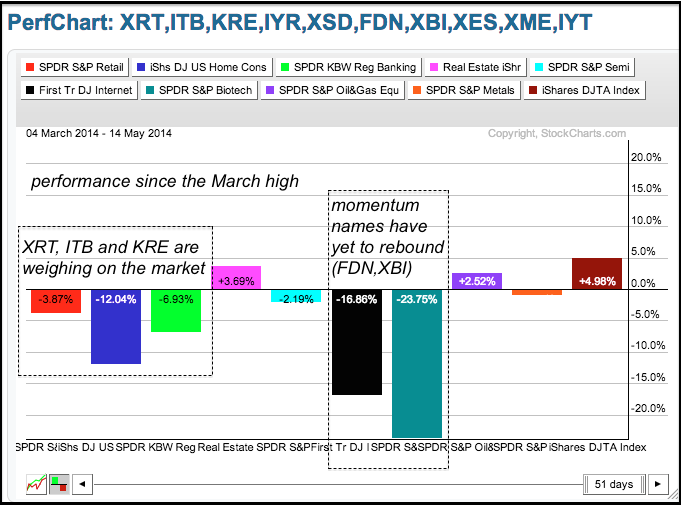Small-caps once again led the market lower with the Russell 2000 ETF and Russell MicroCap iShares losing over 1.5% on the day. The Dow Diamonds and S&P 500 SPDR held up relatively well and lost around .5% on Wednesday. The offensive sectors led lower with the consumer discretionary, technology, finance and industrials sectors losing ground. Weakness in the Home Construction iShares (-2.2%) and Retail SPDR (-1.37%) weighed on the consumer discretionary sector. Weakness in the Regional Bank SPDR (-2.24%) weighed on the finance sector and small-caps. The Gold Miners ETF (+1.09%) bounced along with gold (+.87%), but these gains were not enough to trigger breakouts. Overall, the song remains the same. Relative weakness in retail, homebuilders and regional banks remains a drag on the market, but the market-cap weighted indices are holding up just fine.
**This chart analysis is for educational purposes only, and should not
be construed as a recommendation to buy, sell or sell-short said securities**
*************************************************************
No change. SPY gapped up and surged to a new high early this week and then fell back on Wednesday. First, the gap is bullish. Second, prices continued higher after the gap. After the big April surge, SPY is simply zigzagging higher and the trend here is clearly up (green trend line). The May lows combine to mark key support in the 186-187 area. The indicator window shows the SPY:TLT ratio breaking out as stocks start outperforming bonds.
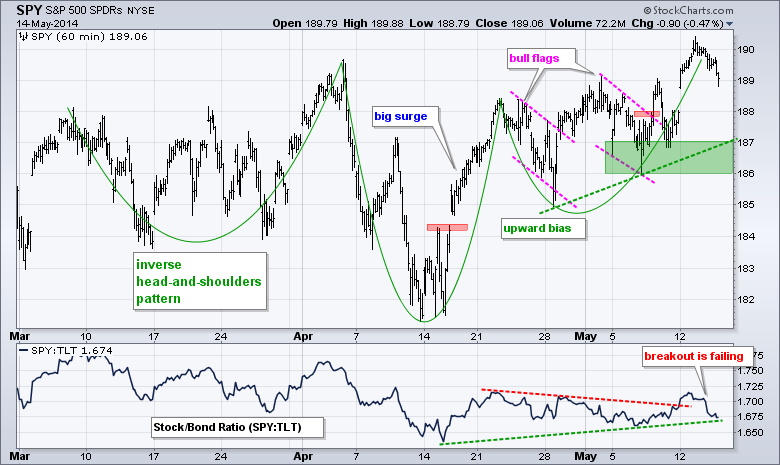
**************************************************************
No change. QQQ found support in the 86 area and surged to resistance with a gap. There is a choppy uptrend working the last few weeks with higher lows and higher highs. The break above resistance at 88 affirms this uptrend with a higher high. The early May lows mark key support in the 85.5-86 area.

**************************************************************
IWM failed at the early May high and fell around 3% in less than two days (113 to 109.62). There are two patterns at work. First, the relatively equal lows and the low high in May combine for a descending triangle, which is a bearish continuation pattern. Second, a bounce back above the 111 level would forge a reaction low and raise the prospect of a small inverse head-and-shoulders. Either way, a break above 113 is needed for a reversal. For now, I think the overall downtrend makes the descending triangle the dominant pattern.

**************************************************************
The 20+ YR T-Bond ETF (TLT) fell to 110.5 with a rather sharp decline and then rebounded after a weak retail sales report on Tuesday. TLT extended to its early May high on Wednesday and continues to attract money, which takes money away from small cap stocks. This bounce keeps the series of higher lows in place and allows me to raise key support. The trend remains up since mid March with support marked in the 109.5-110.5 area.
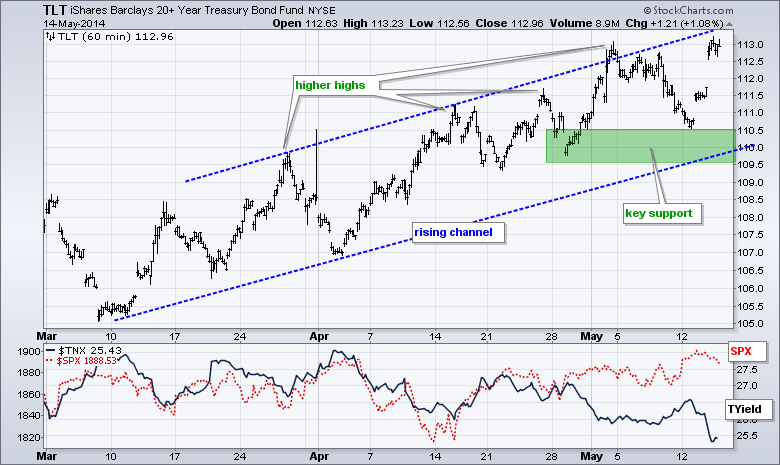
**************************************************************
No change. The US Dollar ETF (UUP) continued higher and broke above the late April highs. The bear trap provided the first sign of a trend reversal and this follow through breakout signals the start of an uptrend. Dollar strength is built on Euro weakness as the Euro Index ($XEU) broke support with a sharp decline over the last few days.

**************************************************************
No change. The USO Oil Fund (USO) broke out with a surge above 36.75 on Tuesday. Overall, the ETF retraced 62% of the prior decline with a falling channel and found support in the 36 area in early May. The trend line break was the first positive and today's break argues for a continuation of the March-April advance. Key support is set at 36.25.
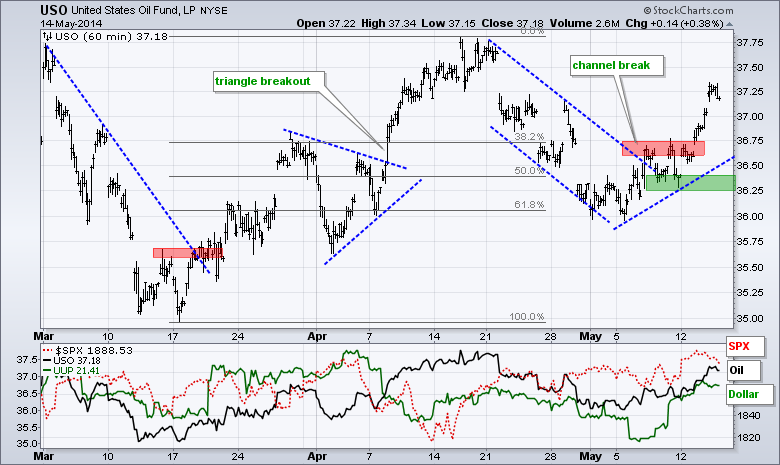
**************************************************************
No change. Gold could not breakout with tensions in Ukraine and must now contend with a strengthening Dollar. The Gold SPDR (GLD) remains with a descending triangle, which is a bearish continuation pattern. The lower high in early May indicates that buying pressure was not strong enough to trigger a breakout or upside follow through to the bounce. The relatively equal lows represent the demand line. A break here would signal a victory for supply and target a move to the 118 area.
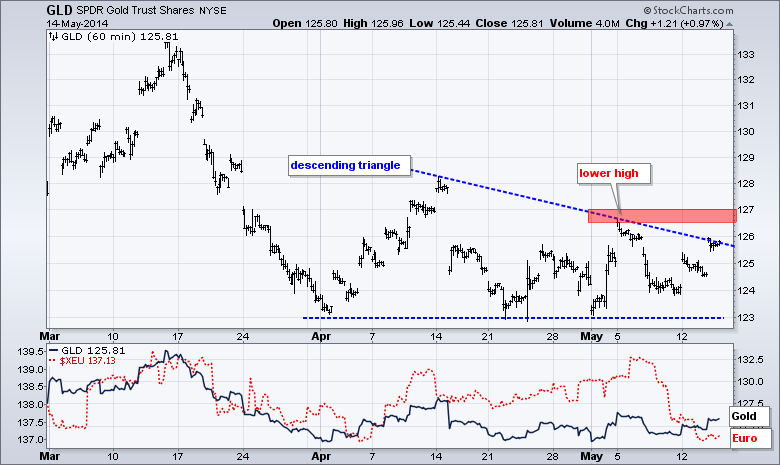
***************************************************************
Key Reports and Events (all times Eastern):
Thu - May 15 - 08:30 - Initial Jobless Claims
Thu - May 15 - 08:30 - Consumer Price Index (CPI)
Thu - May 15 - 08:30 - Empire State Manufacturing
Thu - May 15 - 09:15 - Industrial Production
Thu - May 15 - 10:00 - Philadelphia Fed Index
Thu - May 15 - 10:00 - NAHB Housing Market Index
Thu - May 15 - 10:30 - Natural Gas Inventories
Fri - May 16 - 08:30 - Housing Starts/Building Permits
Fri - May 16 - 09:55 - Michigan Sentiment
This commentary and charts-of-interest are designed to stimulate thinking. This analysis is not a recommendation to buy, sell, hold or sell short any security (stock ETF or otherwise). We all need to think for ourselves when it comes to trading our own accounts. First, it is the only way to really learn. Second, we are the only ones responsible for our decisions. Think of these charts as food for further analysis. Before making a trade, it is important to have a plan. Plan the trade and trade the plan. Among other things, this includes setting a trigger level, a target area and a stop-loss level. It is also important to plan for three possible price movements: advance, decline or sideways. Have a plan for all three scenarios BEFORE making the trade. Consider possible holding times. And finally, look at overall market conditions and sector/industry performance.

